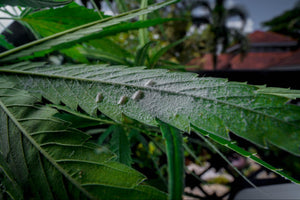Polarity and Selectivity in Cannabis Extraction
Feb 01, 2024
In cannabis extraction, understanding the principles of polarity and selectivity is fundamental to producing the desired cannabis oil in terms of purity, potency, color, clarity, flavor, and consistency.
This blog post explores these key concepts, crucial for isolating the myriad compounds found in cannabis, such as cannabinoids, terpenes, and flavonoids.
We’ll explore how the choice of solvents based on their polarity impacts the extraction efficiency and the quality of the final product and how selectivity is vital in targeting specific compounds to tailor the extract's properties.
Basics of Cannabis Compounds

Understanding the basics of cannabis compounds is essential for comprehending how extraction methods work and why selectivity and polarity are crucial. Cannabis contains a diverse array of bioactive compounds, each with unique properties and effects.
Cannabis Compounds
- Cannabinoids: These are the most well-known compounds in cannabis, with tetrahydrocannabinol (THC) and cannabidiol (CBD) being the most prominent. Cannabinoids interact with the body's endocannabinoid system, affecting mood, pain sensation, appetite, and memory.
- Terpenes: Terpenes are aromatic compounds found in many plants, including cannabis. These volatile compounds contribute to the plant’s aroma and flavor and are believed to influence its effects through a phenomenon known as the "entourage effect."
- Flavonoids and Other Compounds: Cannabis also contains flavonoids, which contribute to the plant's color and have antioxidant properties. Other compounds include lipids, waxes, and chlorophyll.
Compounds in Extraction
Each compound in cannabis has different solubility and reactivity properties, which are influenced by their molecular structure and polarity. During extraction:
- Cannabinoids: The goal is often to extract specific cannabinoids, like THC or CBD, in high concentrations. Their varying polarities make the choice of solvent crucial for efficient extraction.
- Terpenes: Terpenes are generally more volatile and can be lost or degraded if not carefully extracted. Their preservation is vital for maintaining the flavor and potential therapeutic effects of the cannabis extract.
- Flavonoids and Other Compounds: While flavonoids can have beneficial properties, other components like chlorophyll may be undesirable in the final product due to their strong taste and color.
These compounds' complexity and interactions require a nuanced approach to extraction, balancing efficiency, and selectivity.
Becoming familiar with the nature of these compounds helps choose the suitable extraction method and conditions to produce the desired product, whether it's a broad-spectrum extract retaining a range of cannabinoids and terpenes or an isolate containing a single, pure compound.
Polarity in Cannabis Extraction

Polarity, in the context of chemical compounds, refers to the distribution of electric charge over the atoms and molecules of a substance. This characteristic largely influences how different substances interact, dissolve, or repel each other.
In cannabis extraction, the polarity of the solvents and the compounds targeted for extraction is crucial, as it dictates which substances will be dissolved and extracted.
The principle "like dissolves like" is central to understanding the role of polarity in extraction.
Polar solvents like ethanol are more effective at extracting polar compounds, while non-polar solvents, like hydrocarbons (butane and propane), are better suited for non-polar compounds.
This fundamental concept underlies the efficiency of the extraction process – selecting a solvent with a similar polarity to the desired compounds results in more effective and targeted extraction.
Several solvents are commonly used in cannabis extraction, each with its polarity characteristics. For example:
- Ethanol, a polar solvent, is excellent for extracting a wide range of compounds, including both polar and non-polar ones, due to its intermediate polarity.
- Butane and propane, non-polar solvents, are preferred for extracting non-polar compounds like THC and CBD.
- Supercritical carbon dioxide (CO2), a versatile solvent, can have its polarity adjusted with temperature and pressure, making it suitable for extracting a variety of compounds.
In practice, the choice of solvent can significantly impact the profile of the extracted product. For instance, using a polar solvent like ethanol might result in an extract rich in a variety of cannabinoids and terpenes, including more polar compounds like chlorophyll, which might require further refinement to remove.
On the other hand, a non-polar solvent like butane would predominantly extract non-polar compounds, resulting in a different cannabinoid and terpene profile, often with a clearer, purer end product but possibly missing some water-soluble compounds.
Selectivity in Cannabis Extraction

Selectivity in cannabis extraction refers to the ability of a process to isolate specific compounds while excluding others. This concept is crucial for producing extracts with desired properties, such as specific cannabinoid and terpene profiles, while minimizing the presence of undesired elements like fats, waxes, and chlorophyll. High selectivity is often a mark of quality and efficiency in extraction processes.
The selectivity of the extraction process directly influences the purity and quality of cannabis extracts. Highly selective methods ensure that the final product contains a high concentration of targeted compounds, such as THC or CBD, and is free from contaminants and unwanted substances. This not only improves the quality and efficacy of the product but also enhances the safety profile for consumers.
Several techniques can be employed to improve the selectivity of cannabis extraction:
- Temperature Control: Lower temperatures can reduce the solubility of unwanted compounds, thereby increasing selectivity.
- Solvent Choice: As with polarity, the choice of solvent greatly impacts selectivity. For instance, hydrocarbons like butane and propane offer significant selectivity in cannabis extraction. Adjusting temperature and pressure allows these solvents to target specific compounds such as cannabinoids and volatile terpenes.
- Post-Extraction Refinement: Techniques like winterization (removing fats and waxes) and distillation can improve selectivity after initial extraction.
- Pressure Adjustments: In methods like supercritical CO2 extraction, adjusting pressure can change the solvent’s density, influencing its ability to dissolve certain compounds.
Achieving high selectivity in cannabis extraction can present challenges:
- Balancing Efficiency and Selectivity: Increasing selectivity may often reduce the final extract's overall extraction yield.
- Complexity of Cannabis Matrix: The cannabis plant has a complex matrix of compounds, making it challenging to target specific compounds without affecting others.
- Equipment and Cost: Highly selective methods may require advanced equipment and result in higher operational costs.
Methods of Cannabis Extraction

The extraction of cannabis involves various methods, each differing in their approach, efficiency, and quality of the final product. Here, we explore some of the most common methods, focusing on how each manages polarity and selectivity.
Extraction Techniques
- Supercritical CO2 Extraction: This method uses carbon dioxide in its supercritical state, acting as a solvent to extract cannabinoids and terpenes. It's known for its precision, efficiency, and environmental friendliness.
- Ethanol Extraction: Ethanol, a polar solvent, is effective for extracting a wide range of compounds from cannabis. It's favored for its simplicity and ability to produce high-yield extracts.
- Hydrocarbon Extraction: Solvents like butane and propane are used in this method. They are non-polar, making them effective for extracting non-polar compounds like THC and CBD.
- Solventless Extraction: Methods like ice water extraction or dry sifting don't involve solvents. Instead, they rely on heat, pressure, or agitation to extract cannabinoids and terpenes.
Polarity and Selectivity
- Supercritical CO2 Extraction: The ability to adjust temperature and pressure allows fine-tuning the solvent’s polarity, making CO2 extraction highly selective and versatile.
- Ethanol Extraction: The intermediate polarity of ethanol means it extracts a broad range of compounds, including some undesired ones, requiring post-extraction purification steps.
- Hydrocarbon Extraction: These non-polar solvents are highly selective for cannabinoids and terpenes, but they can also extract fats, waxes, and other undesirables if not processed properly.
- Solventless Extraction: While these methods don't use solvents, their selectivity is limited compared to solvent-based methods. They often yield products with a full spectrum of compounds.
Advantages and Limitations
- Supercritical CO2 Extraction: It's safe, clean, and customizable but requires expensive equipment and expertise.
- Ethanol Extraction: It's scalable and efficient but might require significant post-processing to remove unwanted extracts and ensure purity.
- Hydrocarbon Extraction: Known for producing potent extracts with intense flavors and aromas, this method carries risks due to the flammability of the solvents.
- Solventless Extraction: It's safe and natural, preserving the original profile of the cannabis plant material. However, the yield is often lower and less efficient for large-scale production.
Optimizing Cannabis Extraction with Media Bros’ Filtration Media

Filter Media Sample Request
Interested in trying our filter media? We would love to send you some! Browse our products, then fill out this form and someone from our team will be in touch to finalize your request.
Media Bros’ extensive range of filtration media is specially designed to enhance cannabis extraction by fine-tuning selectivity and managing polarity levels. Each product caters to specific needs within the extraction process, ensuring high-quality results.
CRX and CRX-M
CRX™ and its medium flow variant, CRX-M™, are renowned for their high selectivity levels. These products are particularly effective for processing fresh material, where preserving the terpene content is crucial. They target a minimal amount of color compounds, making them ideal for high-quality biomass processing that emphasizes terpene and cannabinoid retention.
CRY and CRY-M
CRY™, with a slightly lower selectivity level than CRX, is capable of targeting a broader range of color compounds and other substances, including heavy metals. This makes CRY an excellent intermediate solution for achieving terpene and cannabinoid retention while also handling several shades of color removal.
CRY and CRY-M™ are tailored for systems operating at higher pressures, ranging from 40-65psi, without the risk of channeling. This makes it ideal for larger systems and operators who need a reliable and robust solution for a variety of biomass, including those with higher moisture content.
CR2
CR2™ is designed for CO2 extraction processes, effectively removing undesirables while maintaining the extract's natural flavor and aroma.
CRAC and G-CRAC
CRAC™, known for its high selectivity and polarity, excels in removing color and pesticides, ideal for ethanol extraction processes. G-CRAC™, a granular activated carbon solution, effectively targets smoke, pesticides, and heavy metals, ensuring a toxin-free final product.
Activated Alumina
Activated Alumina stands out for its high selectivity and less polar nature, making it a robust choice for moisture removal and winterization processes in cannabis oil filtration.
Perform 5000 and Perform 6000
Perform 5000 and Perform 6000, made from activated and bentonite clay, offer less selective but highly polar filtration options, making them effective for a wide range of impurities.
PR-O and PR-W
PR-O and PR-W, both moderately selective and medium polarity, bridge the gap between premium blends and are suitable for various types of biomass and extraction methods.
Silica Gel 60A
Silica Gel 60A, less selective and most polar, is recommended for inline hydrocarbon CRC applications, aiding in thorough impurity removal.
B80
B80, a less selective and more polar medium, is a reliable option for color remediation in hydrocarbon cannabis oil extraction, targeting moderate levels of impurities.
Achieving a Flawless Extraction

Navigating through the nuances of polarity and selectivity in cannabis extraction opens up a world of possibilities for innovation and quality in cannabis products. This exploration enhances our understanding and paves the way for breakthroughs in extraction methodologies.
With each step forward, we're better equipped to harness the full potential of cannabis, promising a future where extracts are more precise, pure, and tailored to diverse needs.







